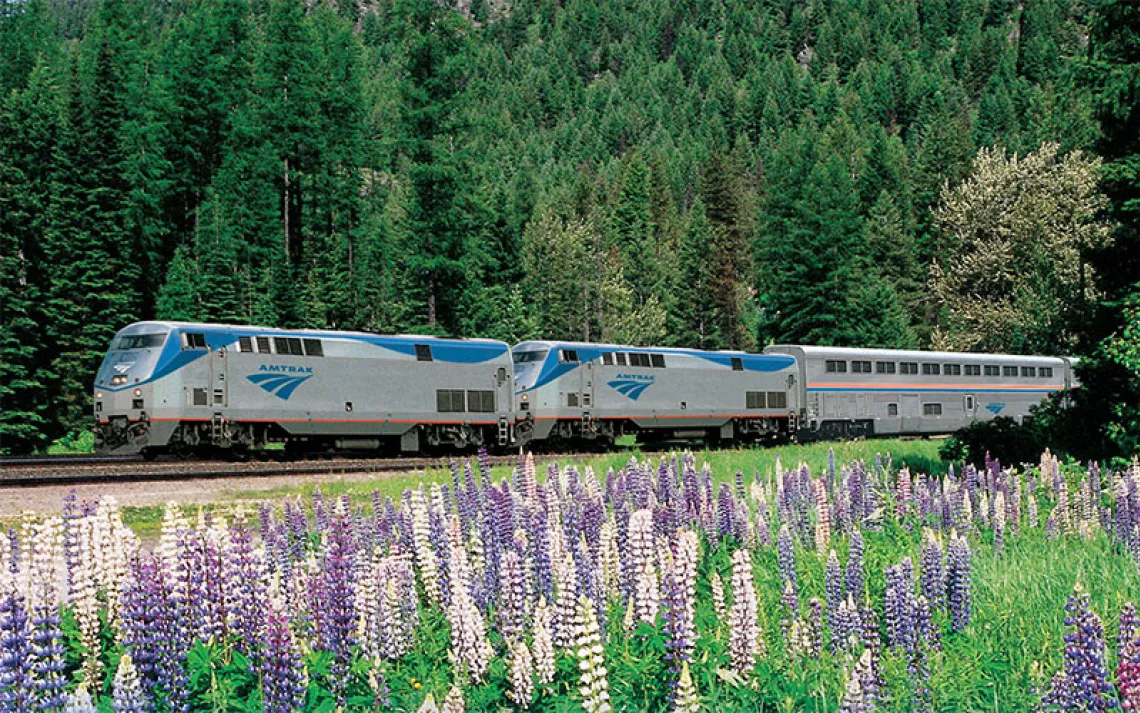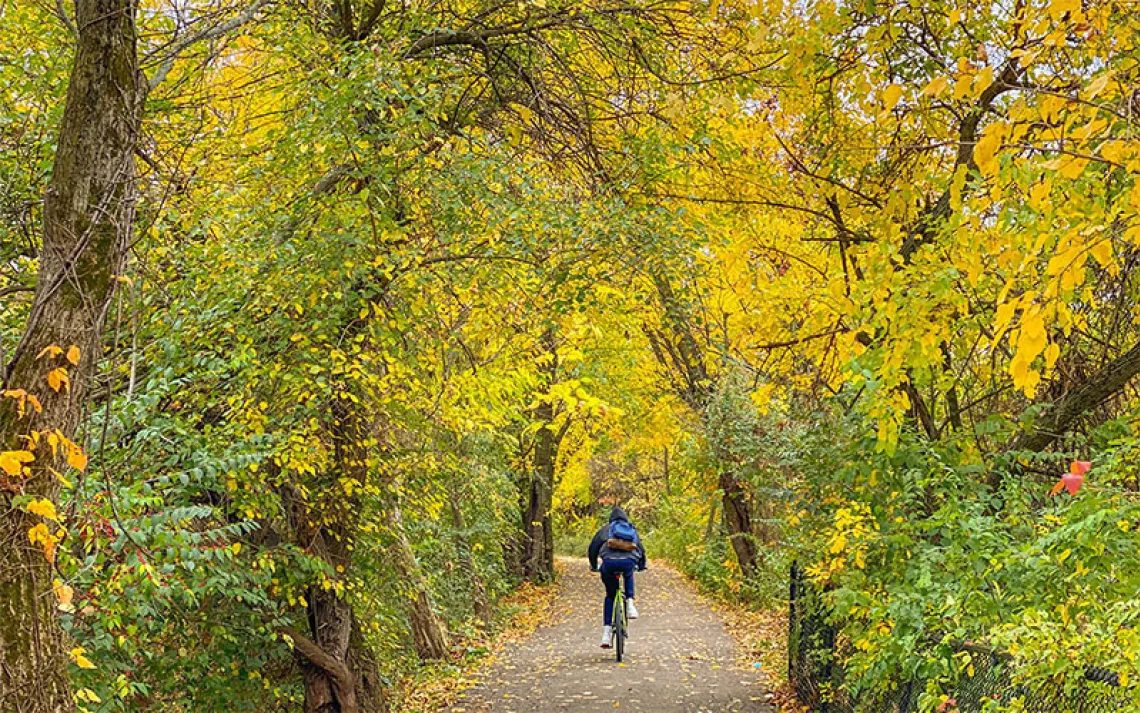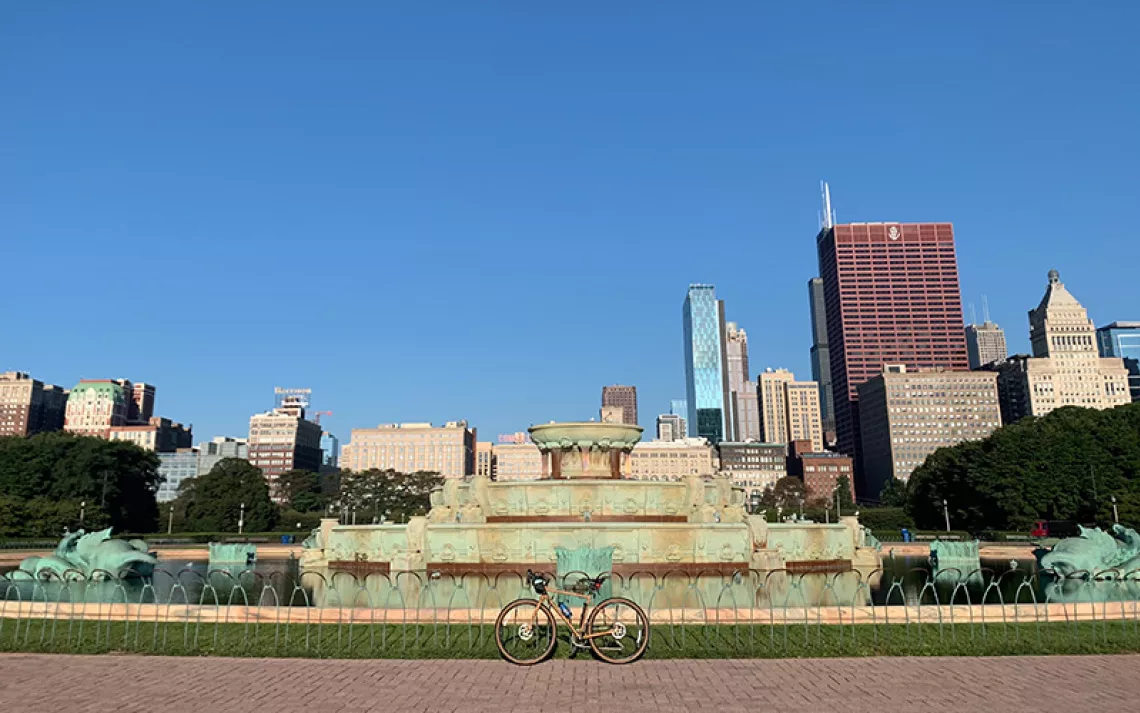Bikepacking Through an Environmental Paradox
A month-long trip offers lesson on climate change and resilience

Kailey celebrates the completion of the 1,000-mile ride. Photo by Galen Knowles.
We completed our first 50 miles when we reached Colorado Creek. Rain poured down at levels I had rarely experienced, and never on a bike. Bright yellow dish-washing gloves covered our hands and plastic shopping bags cinched around our wool socks—an attempt to keep our hands and feet dry. The creek’s name reminded me of home—Colorado River country—so I proposed we stop for the day and set up camp. If only I could bring some of the water soaking my bike shorts back to the drought-ridden Southwest, I thought.
My friend Kailey and I were at the start of a month-long bikepacking trip across Alaska as the recipients of the Lael Rides Alaska Scholarship for women bikepackers. The application called for a 1,000-mile route on Alaska’s few roads. We went a step further and proposed a ride that would also allow us to interview people about climate change along the way. We wanted to feel empowered as women cyclists, but also gain knowledge as young people concerned about a warming world.
The day before we started our journey in early July, Kailey and I witnessed one of Alaska’s more readily visible signs of climate change. From the southern seaside town of Seward—the starting point of our ride—we ventured to Exit Glacier just outside of town. For miles leading up to the glacier, signs note where the glacier used to reach. The frequency of the signs increased the higher we got; the melting that used to occur over a century now happens in the span of a few months.
We stopped by the Kenai Fjords National Park visitor center and asked if someone could talk to us about climate change—a term that has become taboo under the current administration. Young rangers glanced around nervously until veteran ranger Bill Kane offered to share his personal observations. He has been visiting and working at Exit Glacier for the past 25 years. He noted that every October he runs in the Halloween zombie race. It used to always snow on race day. Now he runs the race in shorts.
“How do you cope with witnessing Exit Glacier melt?” I asked.
“It’s gut wrenching,” he replied.
Later that evening, we took a walk through Seward’s small downtown where we found a colorful mural titled “Remembering Exit Glacier.”
Over the following month, Kailey and I biked nearly a direct line north to Deadhorse on the Arctic Ocean. During remote stretches, we camped roadside, pitching our tent in established campgrounds or undeveloped public lands. In towns and cities, generous Alaskans invited us into their home. We bonded with cyclists and environmentalists in Anchorage and learned about thawing permafrost in Denali country. We pedaled through Alaska’s interior, and met with scientists, indigenous organizers, and climate activists in Fairbanks.
Most of our journey followed the Trans-Alaska Pipeline. Since its completion in 1977, over 85 percent of Alaska’s state revenue has come from the oil industry. Yet, the state also finds itself on the frontlines of a warming world. Anna Stringer, a young activist with Alaska Youth for Environmental Action, summarized this predicament when she told us, “Alaska is an environmental paradox.”
The state’s heavy dependence on oil money makes a fossil free future difficult to fathom, but the necessity of such a future feels increasingly urgent as glaciers melt, sea levels rise, and permafrost thaws. While in Fairbanks, we met with Esau Sinnok, a student at the University of Alaska-Fairbanks from the community of Shishmaref, which is located on a barrier island in the Chukchi Sea. Coastal erosion from melting ice and rising seas has pushed his 600-person Inupiaq community to repeatedly vote to relocate since 1973.

Brooke and Kailey pedal along the Seward Highway towards Anchorage. | Photo by Cali Bulmash.

Brooke and Kailey ride through a foggy Arctic, wearing vests tossed to them by truck drivers. | Photo by Galen Knowles.
Sinnok has been a voice for his community around the world—from the 2015 UN Climate Conference in Paris to court rooms in Alaska. He is the lead plaintiff in the case Sinnok v. State of Alaska—a climate lawsuit brought by 16 Alaskan youth organized by Our Children’s Trust, the same organization leading the national climate lawsuit coined the “Trial of the Century.”
When we asked what it will take to relocate his community, Sinnok was skeptical that Shishmaref would receive the 250 million dollars it needs. “FEMA won’t do anything until after it falls apart,” he said.
While still in Fairbanks, we also met with Bernadette Demientieff, the executive director of the Gwich’in Steering Committee, who leads the fight for the porcupine caribou herd and the Gwich’in people threatened by proposed drilling in the Arctic National Wildlife Refuge.
After offering us caribou jerky, Demientieff pointed to a map behind her desk that displays the range of the Porcupine caribou herd and the traditional homelands of the Gwich’in. The two overlapped almost completely. For millennia, the caribou has served as a main food source and central part of the Gwich’in culture. Proposed drilling would occur in the Arctic Refuge’s Coastal Plain, right at the heart of the Porcupine caribou’s calving grounds. The Gwich’in refer to this area as Iizhik Gwats’an Gwandaii Goodlit—The Sacred Place Where Life Begins.
“This is a human rights issue,” Demientieff said. “An attack on the Arctic Refuge is an attack on the Gwich’in people.”
The day after our meeting with Demientieff, Kailey and I biked 84 miles north to the start of the Dalton Highway—a 414-mile remote, mountainous, and mostly unpaved road constructed for the Trans-Alaska Pipeline and oil drilling in the Arctic. Three small “towns” along the way function more as rest stops with expensive food, pricey gas, rarely functioning internet, and Bureau of Land Management visitor centers. The few designated campgrounds rarely lined up with our daily mileage goals. Most often we took advantage of the endless summer sun, pedaling late into the night and looking for a place to pitch our tent at 10 or 11 p.m. We camped everywhere from truck pull offs a few feet from the pipeline to open tundra surrounded by spruce trees.

Brooke summits Atigun Pass. | Photo by Galen Knowles.
Four days after leaving Fairbanks, we reached Wiseman, a 20-person town 188 miles into the Dalton Highway. We stayed with Jack Reakoff, a local hunter, trapper, and tour guide whose family moved to the area before the Dalton Highway was constructed. We slept in one of his historic cabins, walls lined with a taxidermy grizzly, Dall sheep horns, and caribou antlers. The next day, the sun shone warmly and we took a much needed bath in the bitter cold Middle Fork Koyukuk River. Little did we know, this would be the last warm weather we’d enjoy in Alaska.
No services exist for the final 240 miles of the Dalton Highway, which climb over the edge of the Brooks Range and descend through the Arctic tundra. After leaving Wiseman, Kailey and I summited Atigun Pass—the highest highway pass in Alaska—and descended to the western edge of the Arctic Refuge, where we saw caribou munching on tundra plants. The Trans-Alaska Pipeline snaked along a few yards from our pedals, and a grizzly bear wandered far in the distance. Muskoxen—an Ice Age-era, bison-looking creature with a long, thick coat and curved horns—grazed roadside. A red fox with a bird hanging from its mouth ran parallel to us for a half a mile.
For days a dense fog limited our visibility to 10 feet. Some truck drivers heading to the Pruhdoe Bay oil field tossed us their orange construction vests to help other drivers see us. Freezing temperatures and constant rain made the first drizzly days of our journey seem easy in retrospect. I had anticipated rain in Alaska’s temperate rain forest; I did not expect a downpour in Alaska’s arid tundra—on average, the region receives less precipitation than the desert Southwest.
We ended our 1,000-mile ride in what felt like the dark heart of the climate crisis. As the massive infrastructure of the Prudhoe Bay oil fields rose up before us, I struggled to feel celebratory. My hands were numb and my heart ached.
Early in our journey, Kailey had found an Instagram post from a fellow cyclist that described bikepacking as “managing straps and expectations.” Throw a climate story project in with it and you also take on a slew of emotions—from grief and rage to hope and inspiration.
As I stared at the oil fields, I remembered something Allison Barnwell, the coordinator of Alaska Youth for Environmental Action, told us in her urban Anchorage office: “We’re victims of climate change, but we’re doing a lot to try to solve it too. We’re really adaptive people.” Even though climate change and its causes were apparent at every turn, we also found people determined to fight for a thriving future—from the Fairbanks Climate Action Coalition that seeks to create an indigenous-led, “Alaskanized,” just transition away from fossil fuels to the youth who successfully convinced Alaska’s governor to create a climate change leadership team with a dedicated youth seat.
Amid all the feelings, I chose to hold tightest to gratitude. I felt grateful for the opportunity to bike with my best friend through a place that, despite many challenges, still exists wild and resilient.
Follow the Writer’s Footsteps (or Pedal Strokes)
Where:Alaska’s highways from Seward to Deadhorse
Route:Seward HighwayàParks HighwayàSteese HighwayàElliott HighwayàDalton Highway.The Mileposthas super helpful details on every highway in Alaska.
When to Go: June-August. The summer months hold the greatest promise for decent weather, and the sun rarely or never sets. That means you can bike late into the night and never need a headlamp.
What to Bring: Make sure to carry a well-stocked tool kit. We modeled ours off of those used by more experienced adventure cyclists. Pack a three-season tent, warm sleeping bag, and insulated pad. In some places you can drink directly from the streams, but we brought a small water filter to safely replenish our bottles. Carry a canister of bear spray in an easily accessible place and pack a bear bag to keep food safe at night. A small portable speaker also serves as a bear deterrent and is useful for blasting motivating music during tough climbs. Last but not least, bring a friend that makes you laugh a lot.
What to Wear: Layers. Pack a couple lightweight shirts, some thermals, the best rain jacket you can afford, an insulating layer, and your preferred bottoms (we wore bike shorts with chamois).
Pro Tip: Always take candy from strangers. While that betrays what mom taught you, there will be moments when you’re climbing the steepest hill you’ve ever seen and a nice stranger reaches out their hand to offer some sugary goodness. Take it or you may not make it over the next hill.
 The Magazine of The Sierra Club
The Magazine of The Sierra Club



